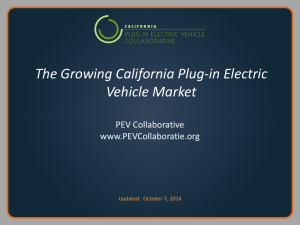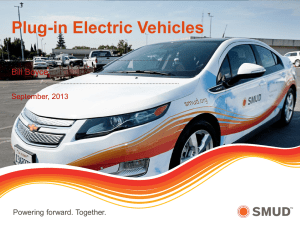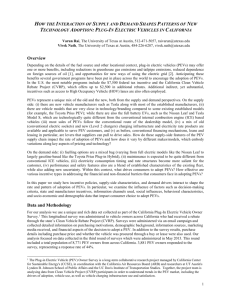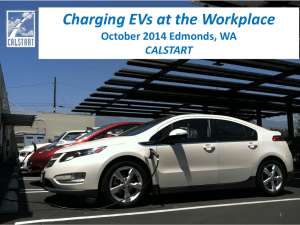Overcoming Barriers to Deployment of Plug-In Electric Vehicles
advertisement
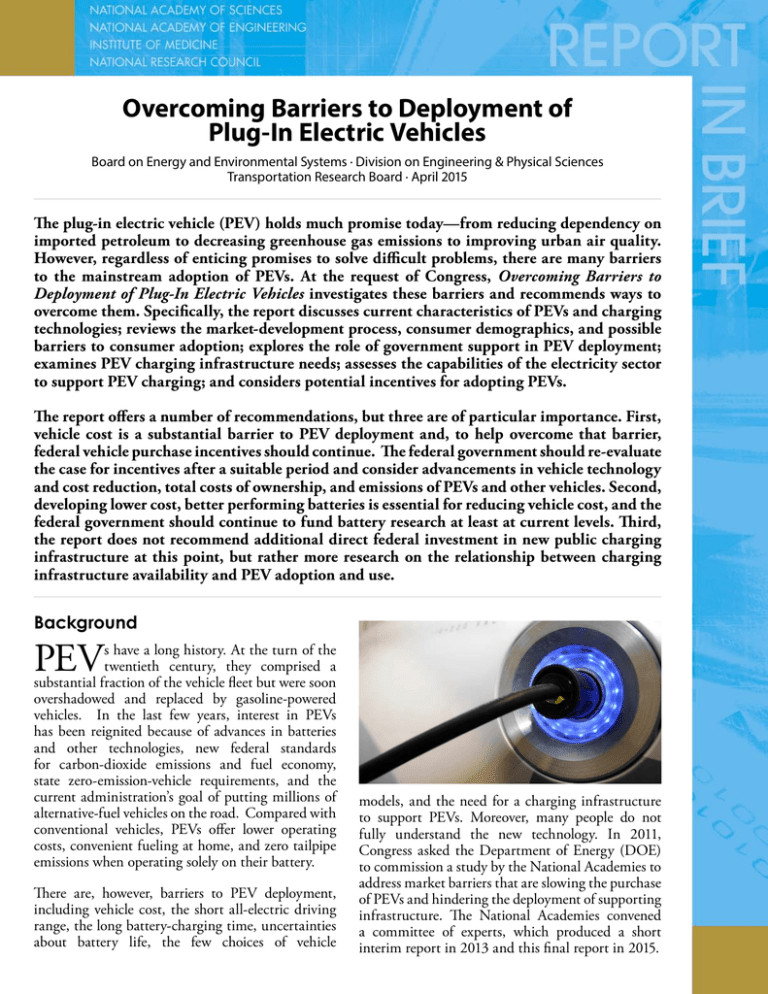
Overcoming Barriers to Deployment of Plug-In Electric Vehicles Board on Energy and Environmental Systems ∙ Division on Engineering & Physical Sciences Transportation Research Board ∙ April 2015 The plug-in electric vehicle (PEV) holds much promise today—from reducing dependency on imported petroleum to decreasing greenhouse gas emissions to improving urban air quality. However, regardless of enticing promises to solve difficult problems, there are many barriers to the mainstream adoption of PEVs. At the request of Congress, Overcoming Barriers to Deployment of Plug-In Electric Vehicles investigates these barriers and recommends ways to overcome them. Specifically, the report discusses current characteristics of PEVs and charging technologies; reviews the market-development process, consumer demographics, and possible barriers to consumer adoption; explores the role of government support in PEV deployment; examines PEV charging infrastructure needs; assesses the capabilities of the electricity sector to support PEV charging; and considers potential incentives for adopting PEVs. The report offers a number of recommendations, but three are of particular importance. First, vehicle cost is a substantial barrier to PEV deployment and, to help overcome that barrier, federal vehicle purchase incentives should continue. The federal government should re-evaluate the case for incentives after a suitable period and consider advancements in vehicle technology and cost reduction, total costs of ownership, and emissions of PEVs and other vehicles. Second, developing lower cost, better performing batteries is essential for reducing vehicle cost, and the federal government should continue to fund battery research at least at current levels. Third, the report does not recommend additional direct federal investment in new public charging infrastructure at this point, but rather more research on the relationship between charging infrastructure availability and PEV adoption and use. Background PEV s have a long history. At the turn of the twentieth century, they comprised a substantial fraction of the vehicle fleet but were soon overshadowed and replaced by gasoline-powered vehicles. In the last few years, interest in PEVs has been reignited because of advances in batteries and other technologies, new federal standards for carbon-dioxide emissions and fuel economy, state zero-emission-vehicle requirements, and the current administration’s goal of putting millions of alternative-fuel vehicles on the road. Compared with conventional vehicles, PEVs offer lower operating costs, convenient fueling at home, and zero tailpipe emissions when operating solely on their battery. There are, however, barriers to PEV deployment, including vehicle cost, the short all-electric driving range, the long battery-charging time, uncertainties about battery life, the few choices of vehicle models, and the need for a charging infrastructure to support PEVs. Moreover, many people do not fully understand the new technology. In 2011, Congress asked the Department of Energy (DOE) to commission a study by the National Academies to address market barriers that are slowing the purchase of PEVs and hindering the deployment of supporting infrastructure. The National Academies convened a committee of experts, which produced a short interim report in 2013 and this final report in 2015. PEV Characteristics Overcoming Barriers to Deployment of Plug-In Electric Vehicles focuses on light-duty vehicles and restricts its discussion to PEVs, which include battery electric vehicles (BEVs) and plug-in hybrid electric vehicles (PHEVs). The common feature of these vehicles is that they charge their batteries by plugging into the electric grid. The distinction between them is that BEVs operate solely on electricity stored in the battery (there is no other energy source), and PHEVs have an internal combustion engine that can supplement the electric powertrain or charge the battery during a trip. The report uses the all-electric range of the vehicles to distinguish four PEV classes (see enclosed figure). Four points should be emphasized about the vehicles. First, the Tesla Model S clearly demonstrates the possibility of producing a long-range BEV. Second, limited-range BEVs are the only type of PEV that have a substantial range limitation. Third, the range-extended PHEV has a total range that is comparable to that of a conventional vehicle because of the onboard internal combustion engine. Fourth, minimal PHEVs with all-electric ranges much shorter than the average daily driving distance are essentially hybrid electric vehicles. Market Development and Customer Purchase Process Adoption and diffusion of PEVs is likely to be a longterm, complex process. One of the main challenges to the success of the PEV market is that people are so accustomed to internal combustion engine vehicles. For an individual consumer, the purchase of a new vehicle is typically a lengthy process that involves substantial research and is strongly affected by the individual’s perceptions. The report identifies various barriers that affect consumer perceptions which, collectively, indicate that consumer awareness of PEV incentives and features is not as great as needed to make fully informed decisions to purchase a PEV. Such consumer uncertainty creates a perceptual hurdle that negatively affects PEV purchases. Recommendation: To provide accurate consumer information and awareness, the federal government should make use of its Ad Council program, particularly in key geographic markets, to provide accurate information about federal tax credits and other incentives, the value proposition of PEV ownership, and who could usefully own a PEV. Government Support The federal government can play an important role in encouraging PEV adoption. Specifically, research in improved battery technology will lower vehicle cost, increase the all-electric range, or both, and likely lead to increased PEV deployment. Recommendation: The federal government should continue to sponsor fundamental and applied research to facilitate and expedite the development of lower cost, higher performing vehicle batteries. Stable funding is critical and should focus on improving energy density and addressing durability and safety. Research is also needed to determine how much public charging infrastructure is necessary and where it should be sited to induce PEV adoption. That research is especially critical if the federal government is allocating resources to fund public infrastructure installation. Recommendation: The federal government should fund research to understand the role of public charging infrastructure (as compared with home and workplace charging) in encouraging PEV adoption and use. One potential barrier for PEV adoption that is solely within government control is taxation of PEVs. Recommendation: The federal and state governments should adopt a PEV innovation policy where PEVs remain free from special roadway or registration surcharges for a limited time to encourage their adoption. Because most charging will occur at home, PEV deployment could be seriously impeded if the buyers must bear high permit and installation costs and experience delays in the activation of their home chargers. Recommendation: Local governments should streamline permitting and adopt building codes that require new construction to be capable of supporting future charging installations. Charging Infrastructure PEV deployment critically depends on the charging infrastructure available. The report categorizes charging infrastructure by location (home, workplace, intracity, intercity, and interstate) and power (AC level 1, AC level 2, and DC fast charging) and analyzes the relative importance of each category. Of greatest importance, home charging is a virtual necessity for all PEV classes given that the vehicle is typically parked at a residence for the longest portion of the day. Residences that do not have access to a dedicated parking spot or one with access to electricity have challenges to overcome to make PEV ownership practical for them. Workplace charging is also very important and offers an important opportunity to encourage PEV adoption. 4 Classes of Plug-In Electric Vehicles Long-Range Battery Electric Vehicle 1 Can travel hundreds of miles on a single battery charge and then be recharged in a relatively short amount of time. example: 265 miles Limited-Range Battery Electric Vehicle More affordable than the long-range battery electric vehicle due to the reduced size of its battery. 2 f Lea n a s is example: 2014 N Its limited range can more than suffice for many commuters, but it is impractical for long trips. 84 miles Range-Extended Plug-In Hybrid Electric Vehicle 3 Operates as a zero-emission vehicle until its battery is depleted. example: 2014 Ch e Then, an internal combustion engine turns on to recharge the battery and extend its range. 38 miles ol t V t e vrol 380 miles Minimal Plug-In Hybrid Electric Vehicle ex am Its small battery can be charged from the electric grid, but it has an all-electric range that is much smaller than the average daily U.S. driving distance. = All-Electric Range 1 Image by Concavo Wheels, under Creative Commons 2 Image by Nissan for editorial use r iu s Mostly a hybrid electric vehicle. 4 = Gas + Electric Range 3 Image by General Motors for editorial use 4 Image by Mariordo, under Creative Commons ple : 2014 Toyota Plu 6 miles in g- P 540 miles Cars and ranges are only examples of each category from the report. Specifically, workplace charging could double the daily travel distance that is fueled by electricity if combined with home charging. Recommendation: Local governments should engage with and encourage workplaces to consider investments in charging infrastructure and provide information about best practices. Public charging infrastructure has the potential to provide increased confidence, range, and value for PEV drivers. However, fundamental questions need to be answered. How much and what type of public charging infrastructure is needed? Where should it be located? Recommendation: The federal government should refrain from additional direct investment in the installation of public charging infrastructure pending an evaluation of the relationship between the availability of public charging and PEV adoption or use. Plug and protocol incompatibility is also a barrier to PEV adoption. In the United States, there is one standard plug for the AC level 1 and AC level 2 chargers, but there are at least three incompatible plugs and communication protocols being used for DC fast charging. Recommendation: The federal government and proactive states should use their incentives and regulatory powers to (1) eliminate the proliferation of plugs and communication protocols for DC fast chargers and (2) ensure that all PEV drivers can charge their vehicles and pay at all public charging stations using a universally accepted payment method just as any internal combustion engine vehicle can be fueled at any gas station. Implications for the Electricity Sector At the current time, PEV charging requirements account for about 0.02 percent of the energy produced and consumed in the continental United States. Were the PEV fleet to reach as high as 20 percent of private vehicles, the estimated impact would still be only 5 percent of today’s electric production. Although some upgrades to the distribution infrastructure might be required in areas where there is high, concentrated PEV deployment, PEV charging is expected to have a negligible effect on the distribution system at the anticipated rates of PEV adoption. Thus, the constraints on PEV adoption that could arise from the electricity sector are more likely to be economic rather than physical or technical. Recommendation: To ensure that adopters of PEVs have incentives to charge vehicles at times when the cost of supplying energy is low, the federal government should propose that state regulatory commissions offer PEV owners the option of purchasing electricity under time-of-use or realtime pricing. Incentives for PEV Deployment Determining the need for incentives is difficult because little is yet known about the effectiveness of PEV incentive programs. To consider the effect of vehicle price and cost of ownership on PEV adoption, the report reviews sales and consumer survey data and retail prices for a selection of PEVs, hybrid electric vehicles, and conventional vehicles. Although the sales and survey data are difficult to interpret, they are consistent with the view that price is a barrier to some buyers but that others might be rejecting PEVs for other reasons. A comparison of retail prices and cumulative ownership costs that incorporate current federal tax credits provides mixed evidence on whether price is currently an obstacle to PEV adoption; however, in the absence of tax credits and other subsidies, comparisons at today’s retail prices would be unfavorable to PEVs. FIGURE: PEV charging infrastructure categories, ranked by their likely importance to PEV deployment, with the most important, home charging, on the bottom, and the least important, interstate DC fast charging, at the top. Recommendation: Federal financial incentives to purchase PEVs should continue to be provided beyond the current production volume limit as manufacturers and consumers experiment with and learn about the new technology. The federal government should re-evaluate the case for incentives after a suitable period, such as 5 years. Its re-evaluation should consider advancements in vehicle technology and progress in reducing production costs, total costs of ownership, and emissions of PEVs, hybrid electric vehicles, and internal combustion engine vehicles. Recommendation: Given the research on effectiveness of purchase incentives, the federal government should consider converting the tax credit to a point-of-sale rebate. Existing federal and state regulatory programs for fueleconomy and emissions have been effective at stimulating manufacturers to produce some PEVs and price them more attractively. State zero-emission-vehicle requirements have been particularly effective at increasing PEV production and adoption. Furthermore, state and local governments offer a variety of financial and non-financial incentives, but there is a lack of research to indicate which incentives might be the most effective. Recommendation: Given the sparse research on incentives other than financial purchase incentives, research should be conducted on the variety of consumer incentives that are (or have been) offered by states and local governments to determine which, if any, have proven effective in promoting PEV deployment. Committee: John Kassakian, Massachusetts Institute of Technology, Chair; David Bodde, Clemson University; Jeff Doyle, D’Artagnan Consulting; Gerald Gabrielse, Harvard University; Kelly Sims Gallagher, Tufts University (left committee June 2014); Roland Hwang, Natural Resources Defense Council; Peter Isard, Consultant; Linos Jacovides, Michigan State University; Ulric Kwan, IBM Global Business Services; Rebecca Lindland, King Abdullah Petroleum Studies and Research Center; Ralph Masiello, DNVGL, Inc.; Jakki Mohr, University of Montana; Melissa Schilling, New York University Stern School of Business; Richard Tabors, Across the Charles; Thomas Turrentine, University of California, Davis Staff: Ellen K. Mantus, Study Co-Director; K. John Holmes, Study Co-Director; James Zucchetto, Board Director; Joseph Morris, Senior Program Officer; Norman Grossblatt, Senior Editor; Michelle Schwalbe, Program Officer; Elizabeth Zeitler, Associate Program Officer; Ivory Clarke, Senior Program Assistant; Linda Casola, Senior Program Assistant This study was supported by a contract between the National Academy of Sciences and the U.S. Department of Energy. Any opinions, findings, conclusions, or recommendations expressed in this publication are those of the author(s) and do not necessarily reflect the views of the organizations or agencies that provided support for the project, or the National Research Council. Copies of this report are available free of charge from http://www.nap.edu. Report issued April 2015. Permission granted to reproduce this brief in its entirety with no additions or alterations. Permission for images/figures must be obtained from their original source. © 2015 The National Academy of Sciences
